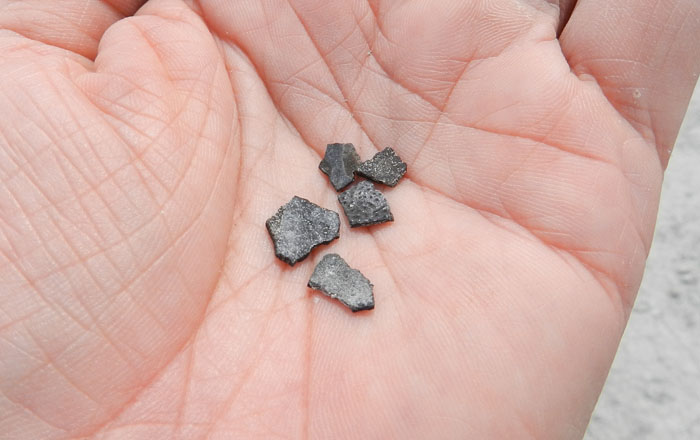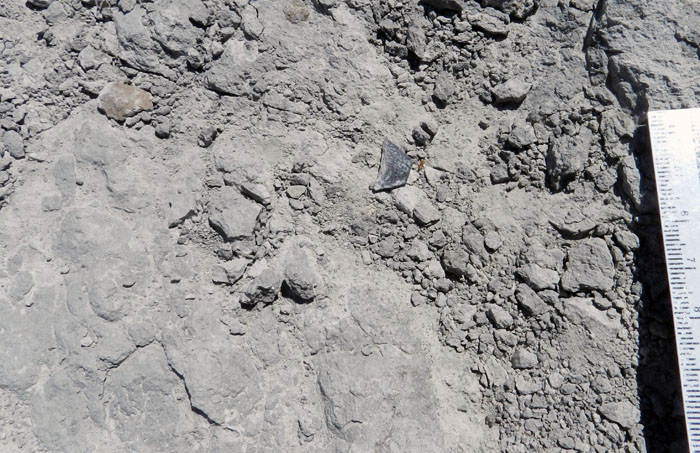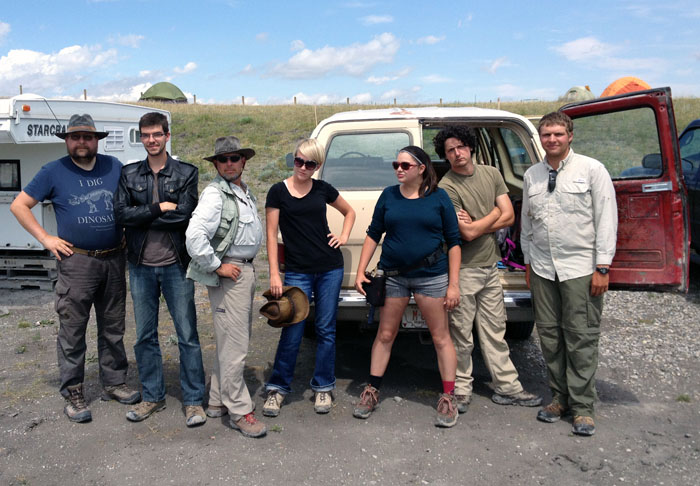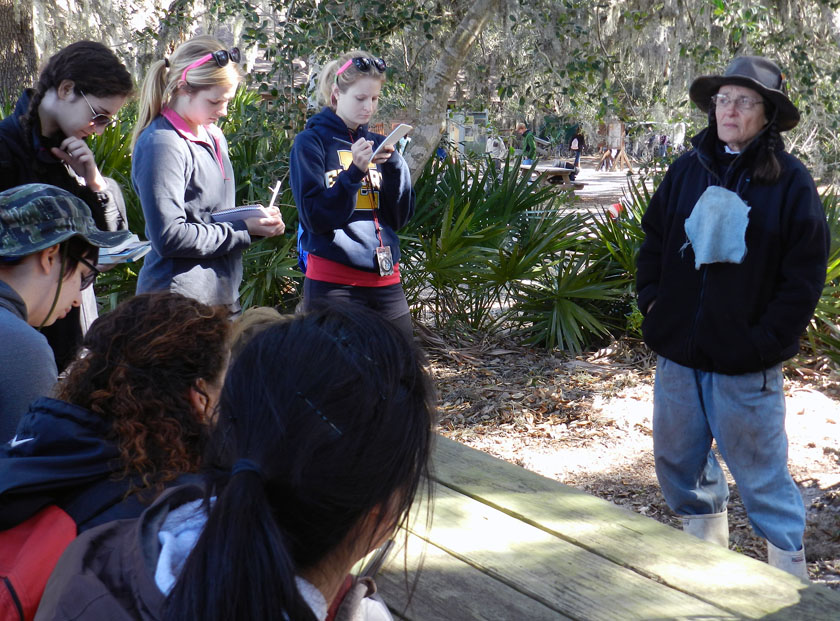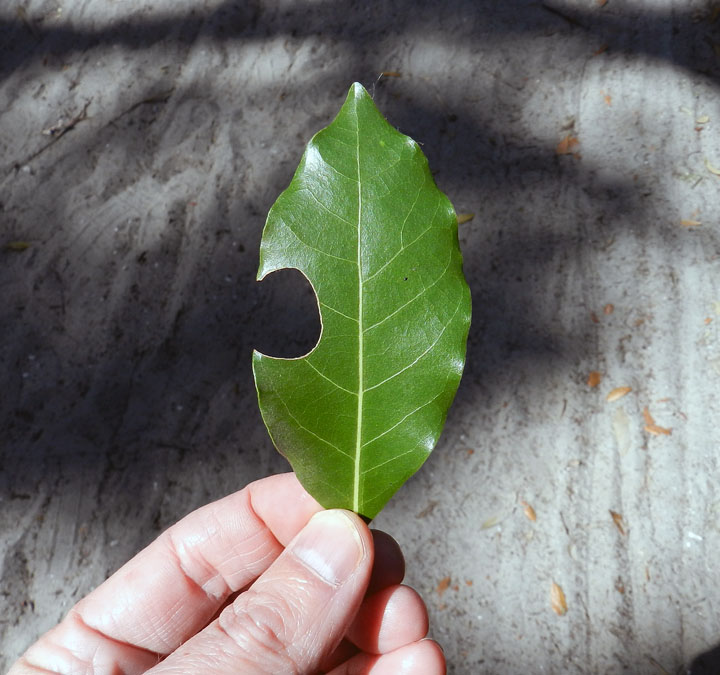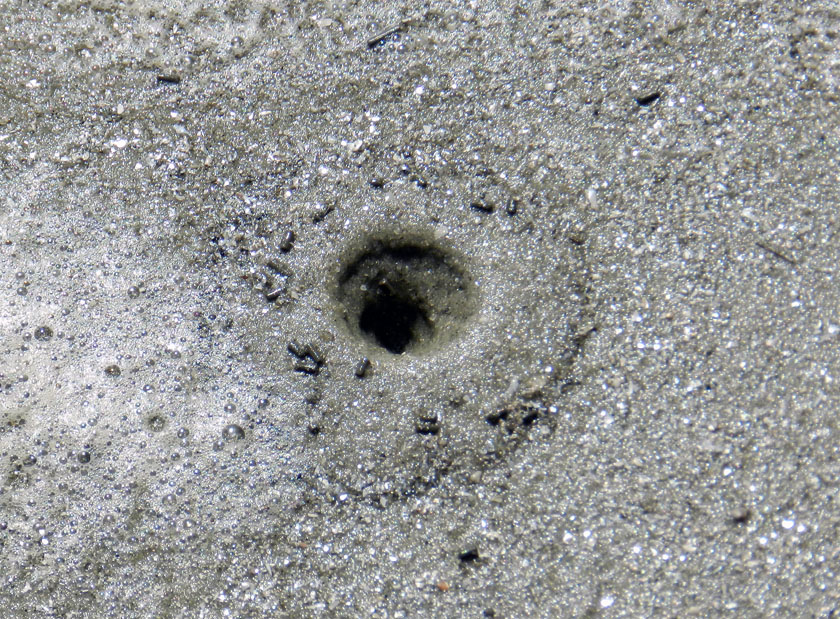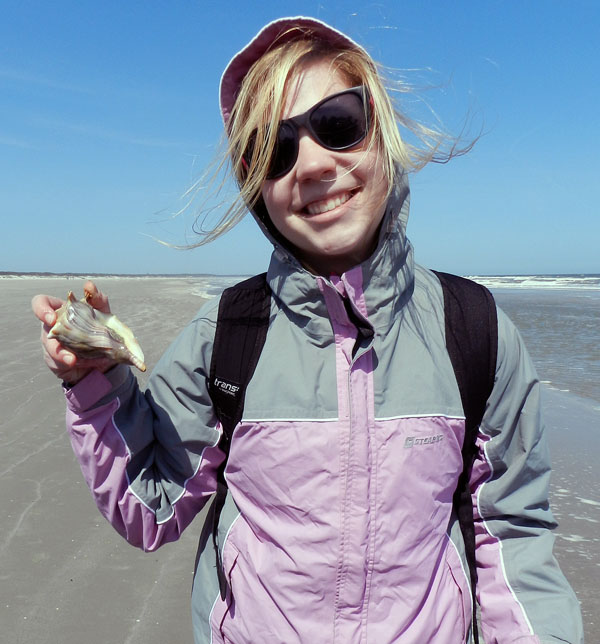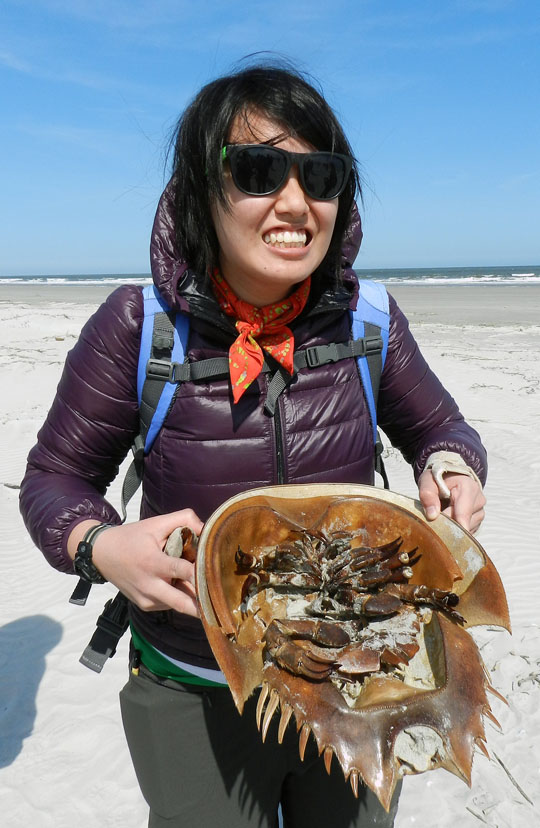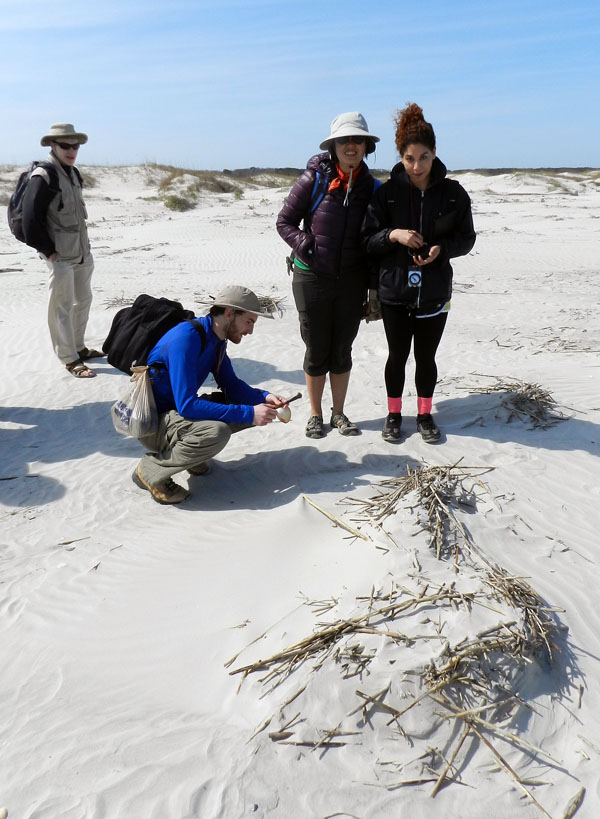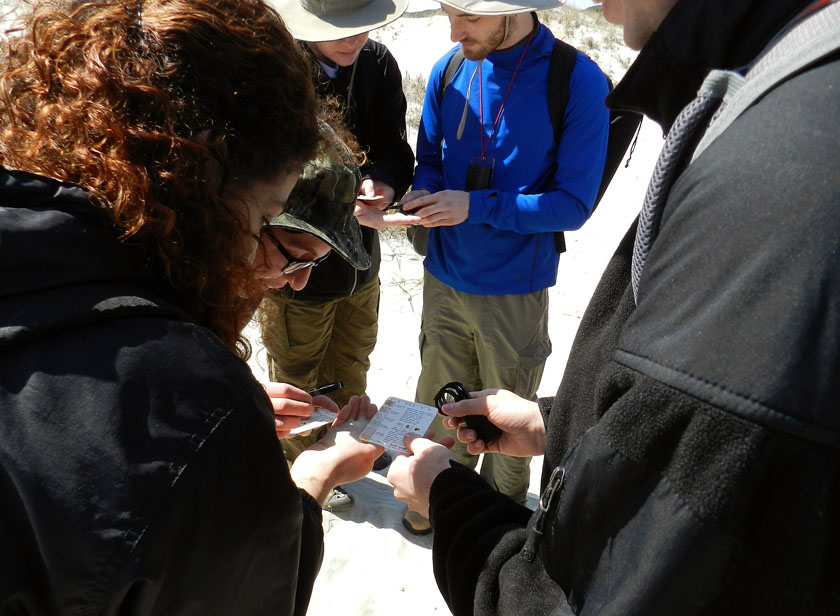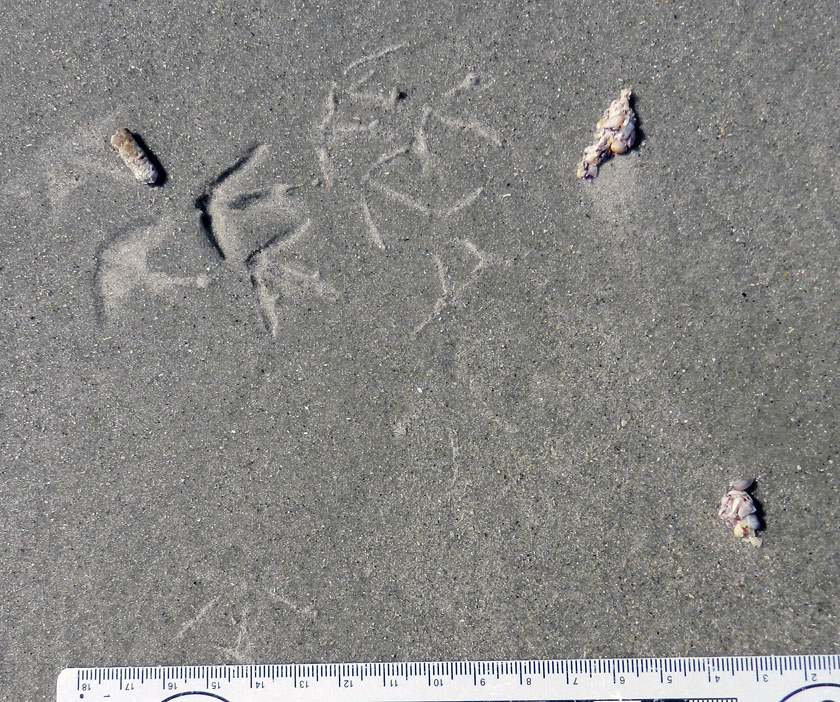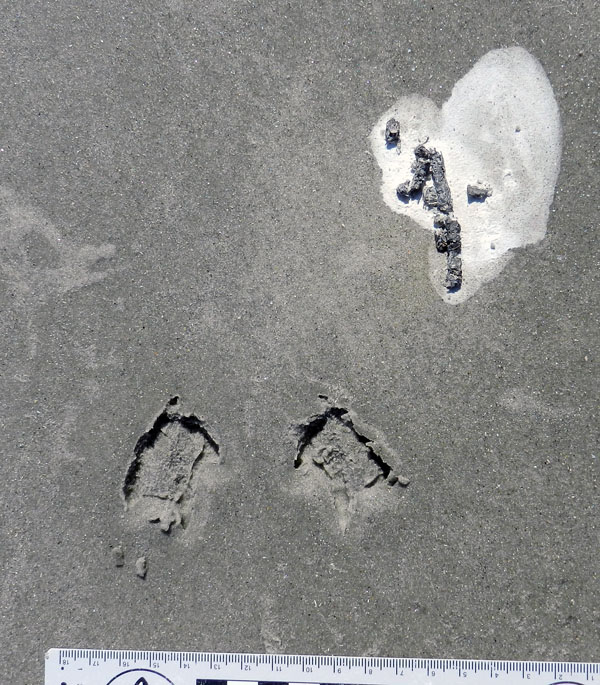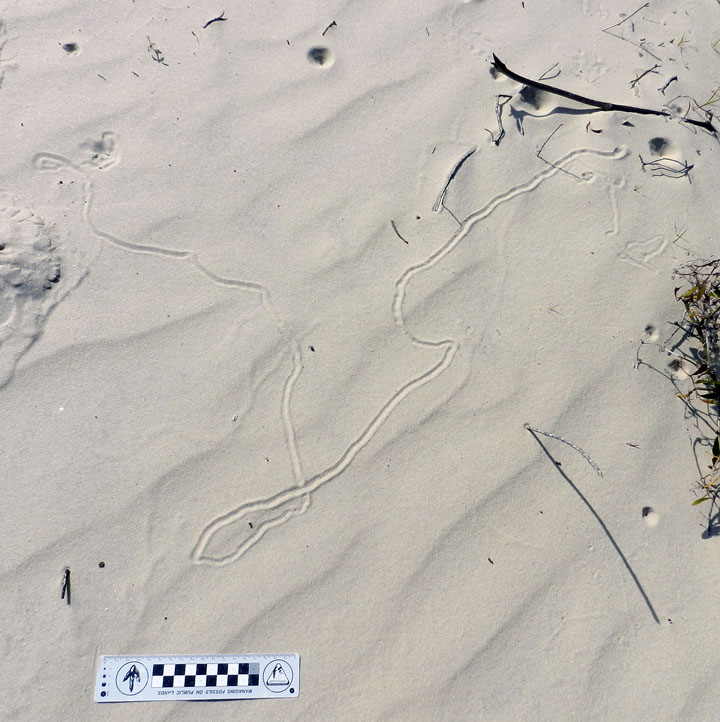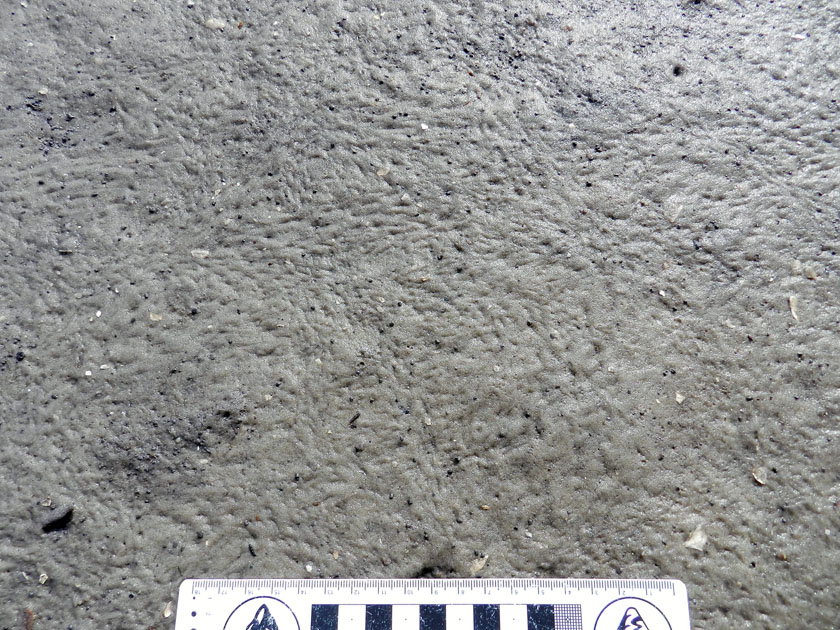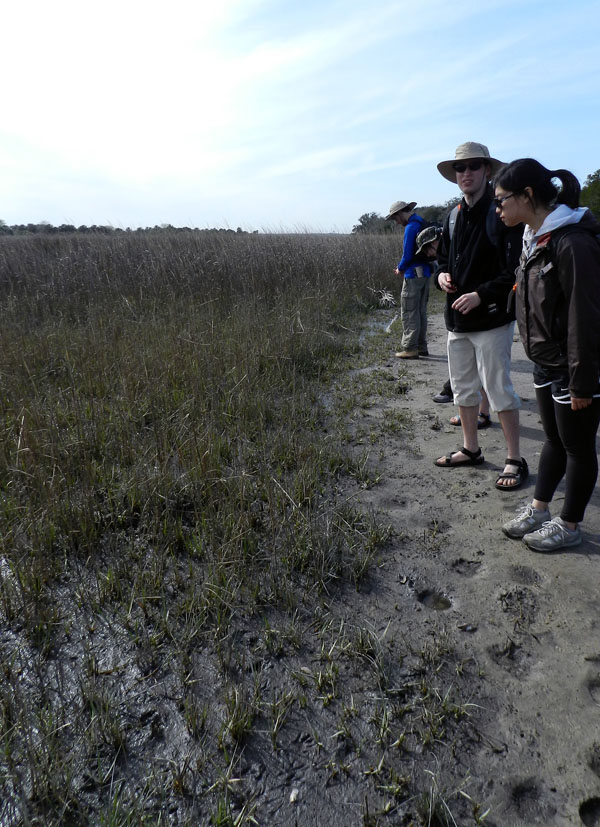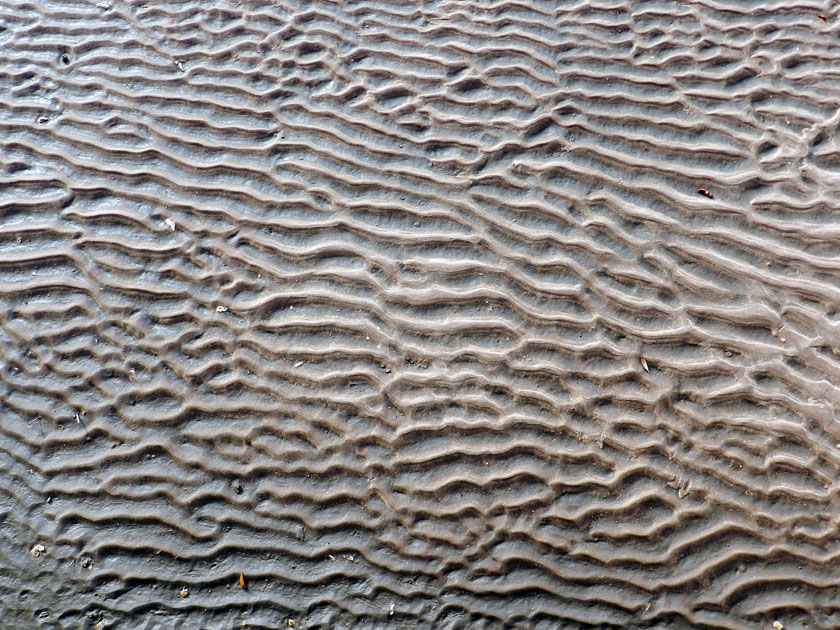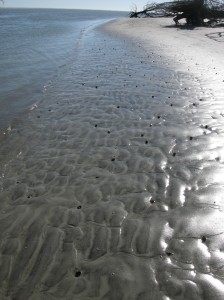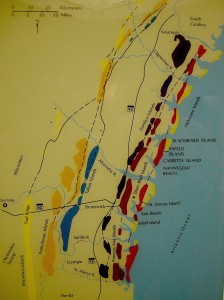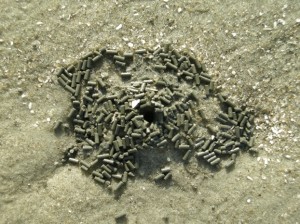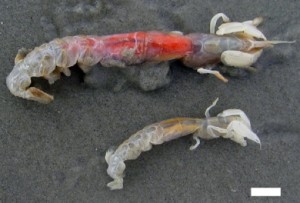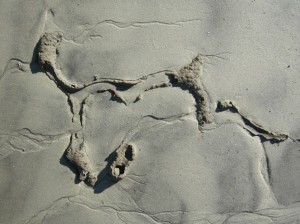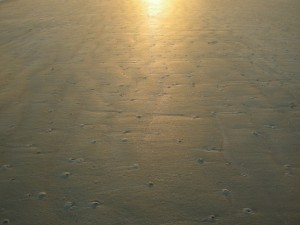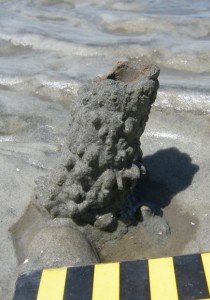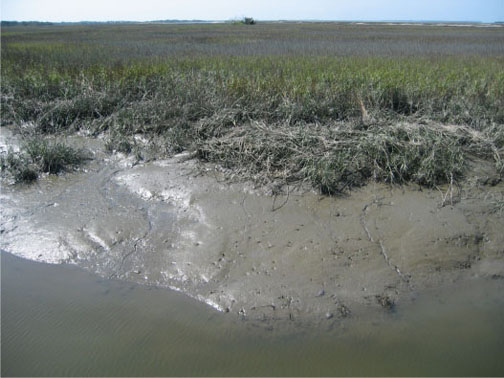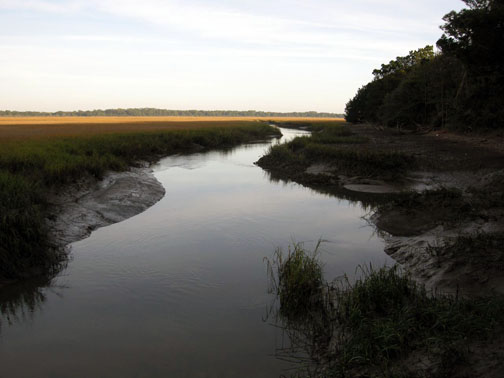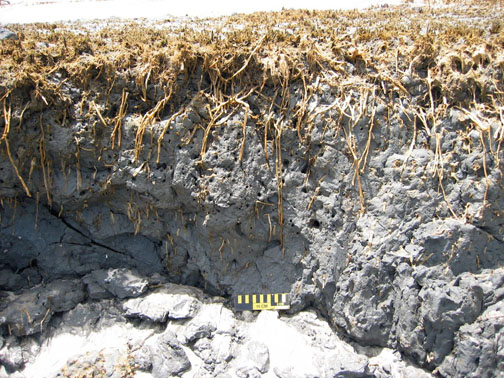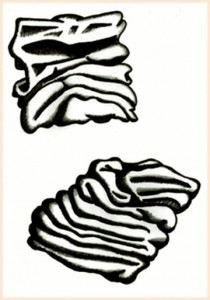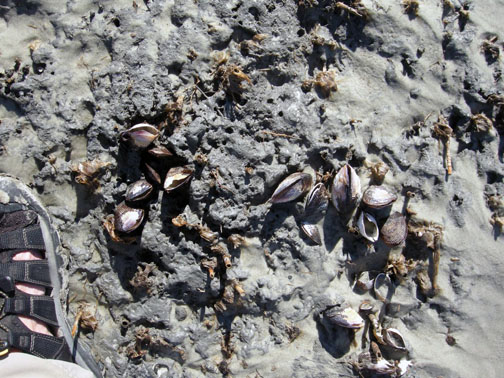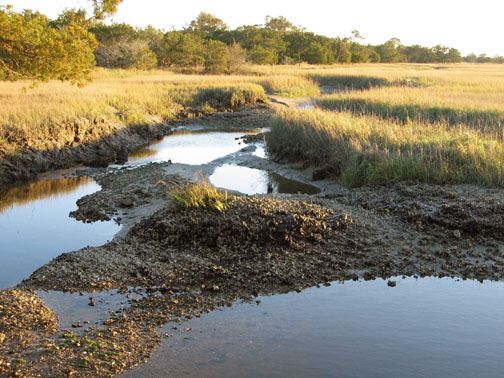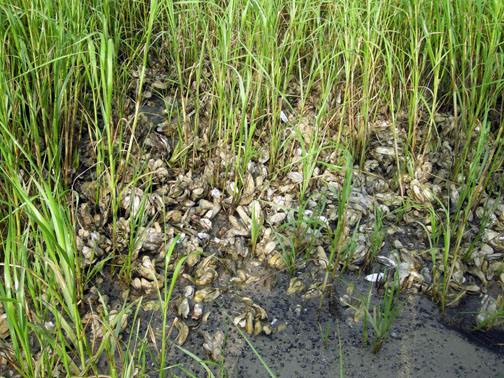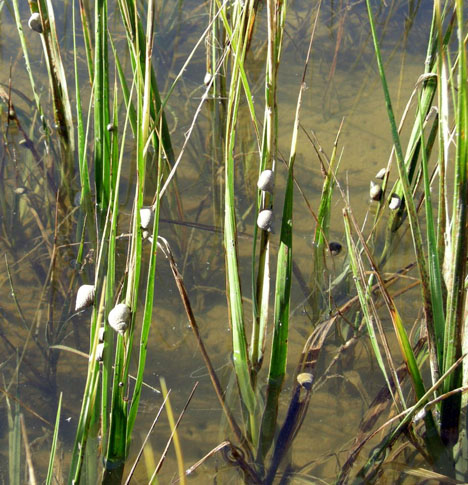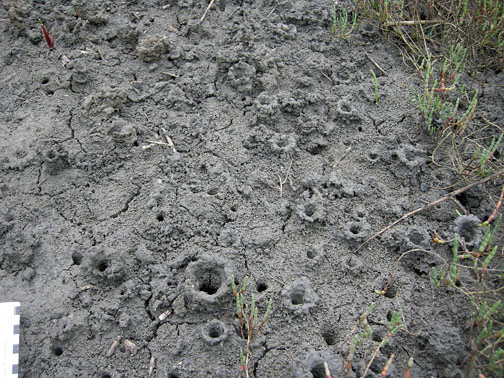While strolling through the beautiful and historic city of Savannah, Georgia last week, I made sure to pay attention to the thousands of time machines below my feet. Yes, I know, everyone other than geologists stubbornly refer to these objects as “rocks.” Fortunately, though, we earth scientists don’t have to limit our imaginations by using such simplistic labels. These pieces of a pre-human past all have stories to tell of their origin, and sometimes they even connect to our treatment of one another as human beings.
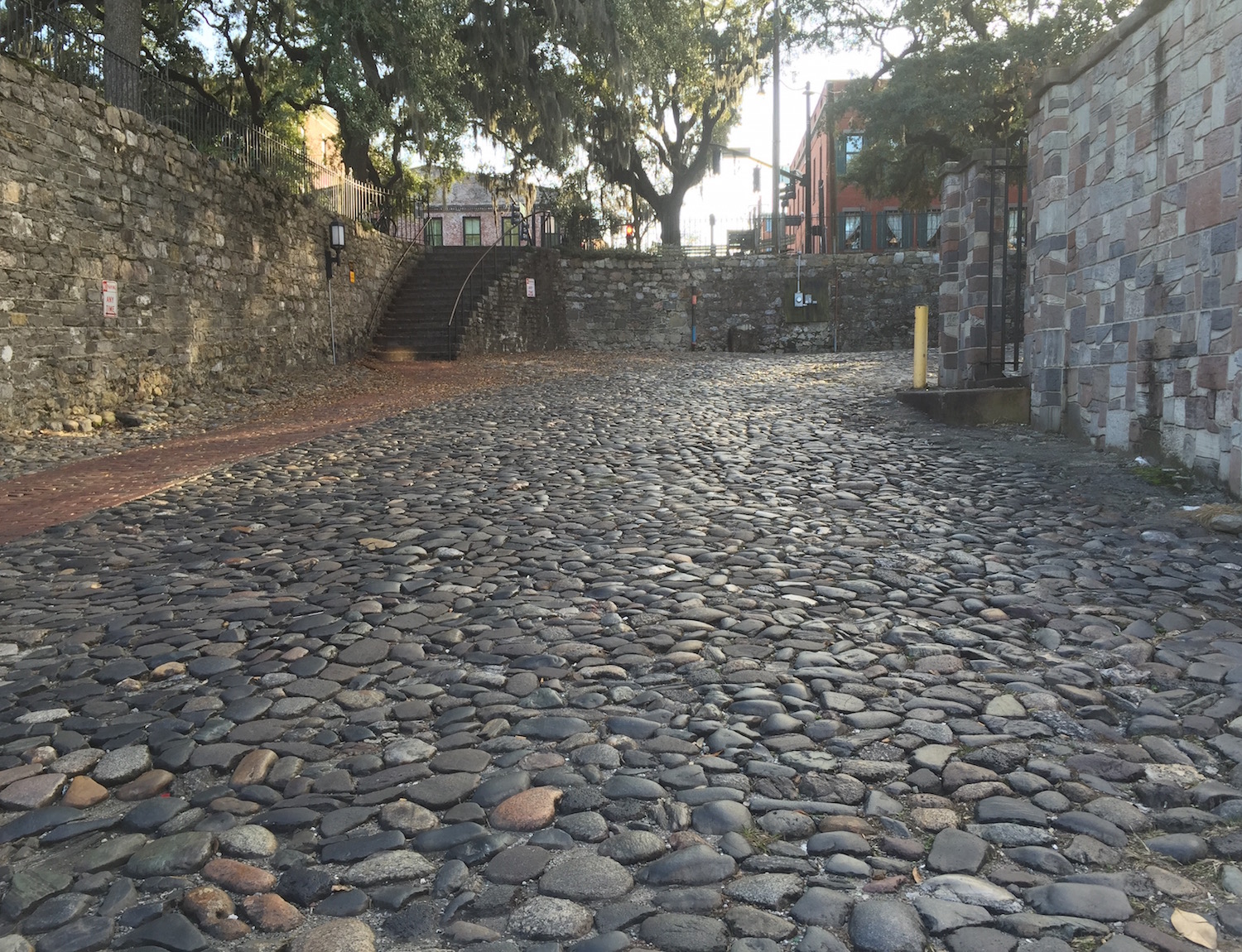 A street on the north edge of Savannah, Georgia leading down to the Savannah River, composed of rocks from afar. How did these rocks get there, and what stories do they tell us about themselves and us? (Photo by Anthony Martin.)
A street on the north edge of Savannah, Georgia leading down to the Savannah River, composed of rocks from afar. How did these rocks get there, and what stories do they tell us about themselves and us? (Photo by Anthony Martin.)
Temporal considerations aside, the rocks of Savannah don’t really belong there. This is especially true for those on the north end of town cobbling the roads and reinforcing walls next to the Savannah River. A quick glance at these stones by the geologically informed reveals how these are all foreign to this part of Georgia. Sure enough, most are from across the Atlantic Ocean, with the majority probably originating in the British Isles. Yet they also have been part of Savannah history for at least a few hundred years. What are they, how did they get there, and why are they there?
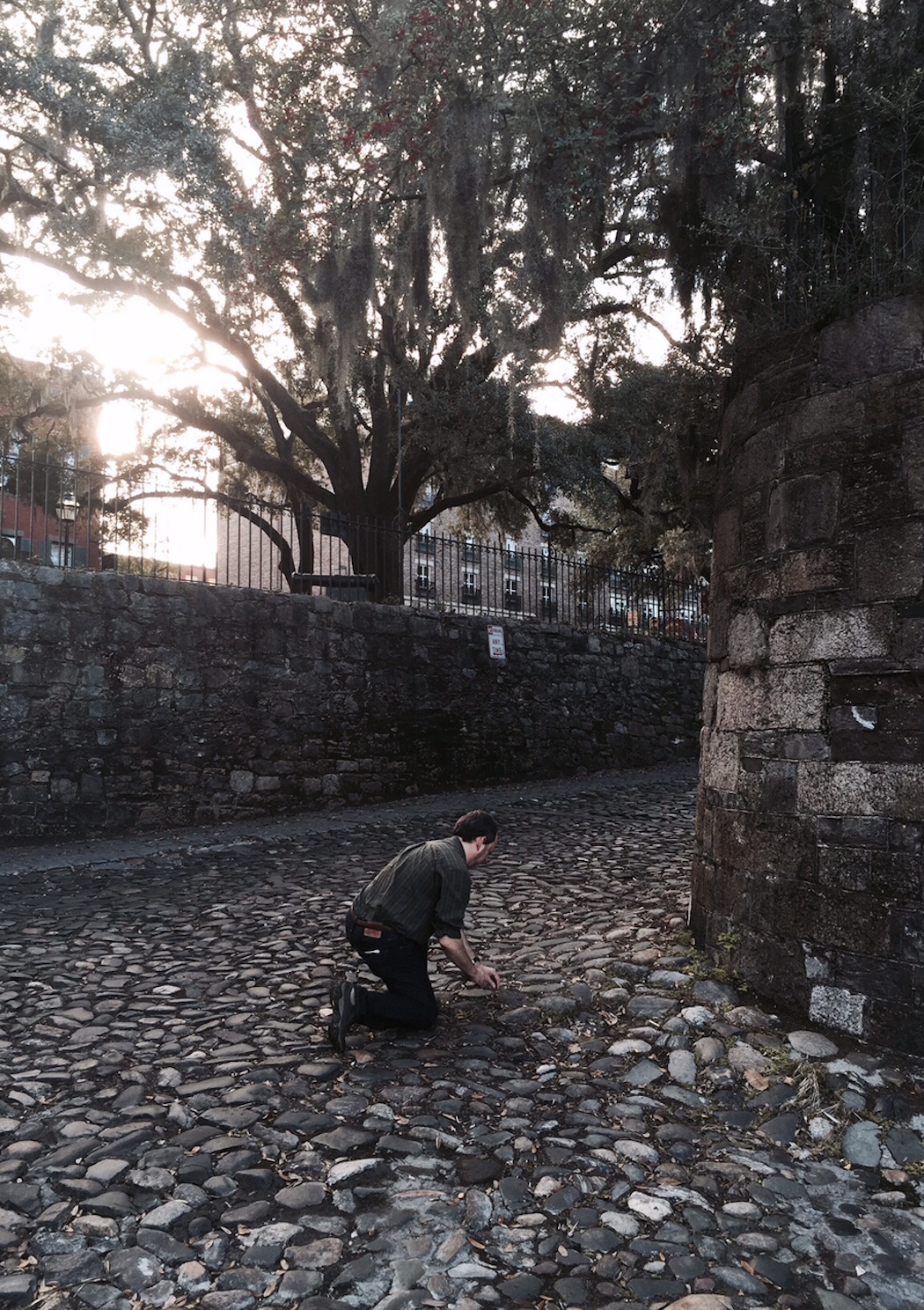 A fine example of how rocks and a geologist (me, in this instance) get along just fine, especially when that geologist kneels in their presence. Note also the stone walls on either side of the street, which also figure into the origin story of these stones. (Photo by Ruth Schowalter.)
A fine example of how rocks and a geologist (me, in this instance) get along just fine, especially when that geologist kneels in their presence. Note also the stone walls on either side of the street, which also figure into the origin story of these stones. (Photo by Ruth Schowalter.)
These are ballast stones, which filled the holds of ships during the 18th and 19th centuries as they sailed across the Atlantic Ocean from England. Were these ships exporting rocks to eager colonists who wished to collect nostalgic (and solid) reminders of their former homelands? No, ballast stones were used to keep ships weighted down, which helped to stabilize them as they moved across seas both calm and rough.
Once a ship reached Savannah – which began as a British settlement in 1733 – its crew would dump its rocky cargo and replace its relatively uneconomic value with goods grown in Georgia, such as rice, cotton, and indigo. Those economic commodities then went across the ocean, where they were used for food (rice) or textiles (cotton and indigo). Meanwhile, the ballast stones were repurposed as durable materials for the streets, walls, and houses along the Savannah River, as well as in some of the older homes in the historic district of Savannah.
The rocks on the streets and in the walls of Savannah are amazingly varied, reflecting the geological diversity of the United Kingdom and perhaps other places. (Admittedly, I haven’t done an exhaustive literature search on this topic yet: This is only a blog post, y’all.) Igneous, metamorphic, and sedimentary rocks are all represented, but perhaps the most common type I saw was basalt, which is a black, fine-grained extrusive (volcanic) igneous rock.
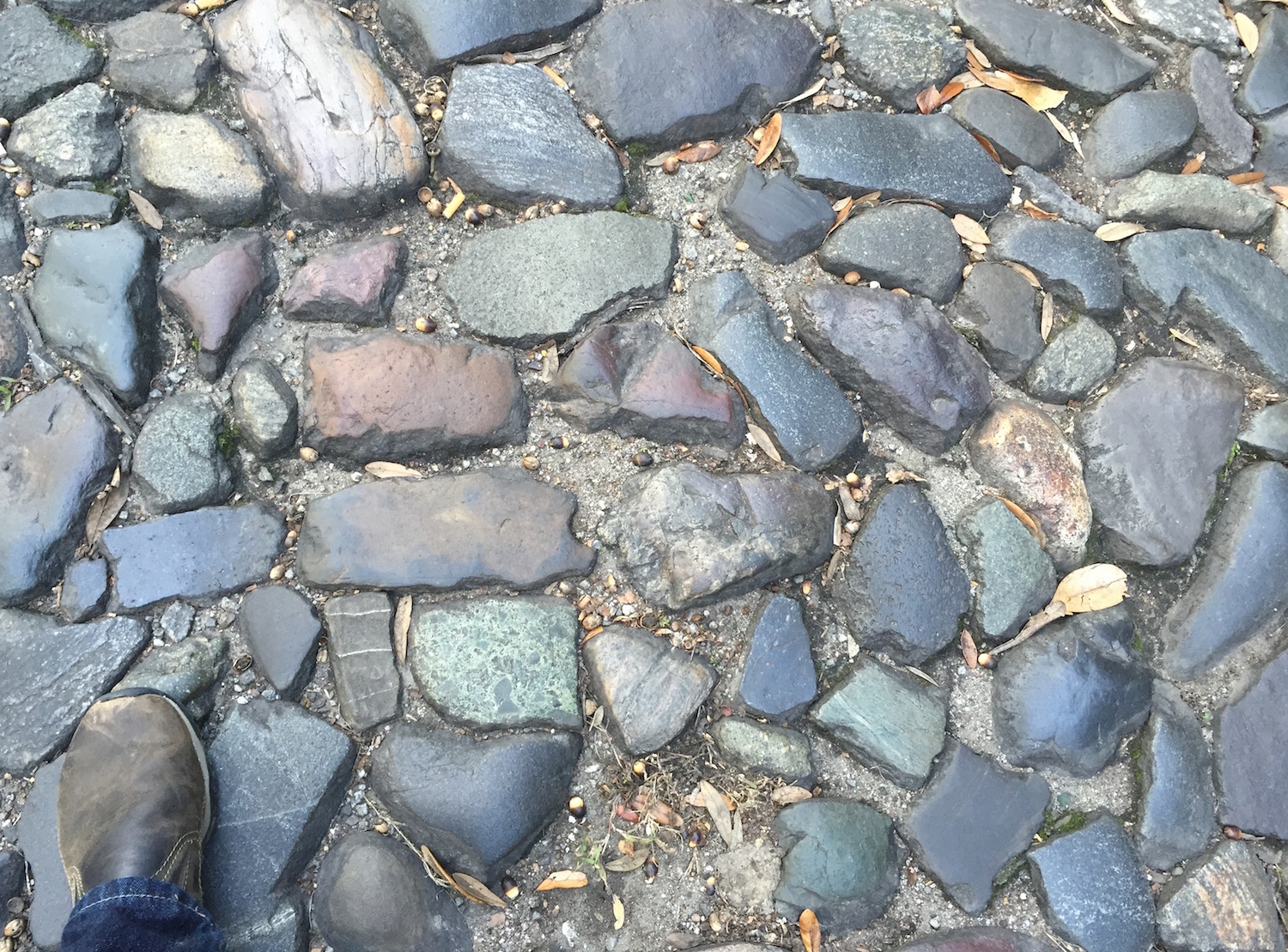 A nice sample of the geologically diverse rocks composing a street in downtown Savannah, Georgia. Geologists glancing at this photo will no doubt spot representatives of the Holy Trinity of Lithology in this assemblage: Igneous, Metamorphic, and Sedimentary. Amen! (Scale = size 8 1/2 shoe (mens); photo by Anthony Martin.)
A nice sample of the geologically diverse rocks composing a street in downtown Savannah, Georgia. Geologists glancing at this photo will no doubt spot representatives of the Holy Trinity of Lithology in this assemblage: Igneous, Metamorphic, and Sedimentary. Amen! (Scale = size 8 1/2 shoe (mens); photo by Anthony Martin.)
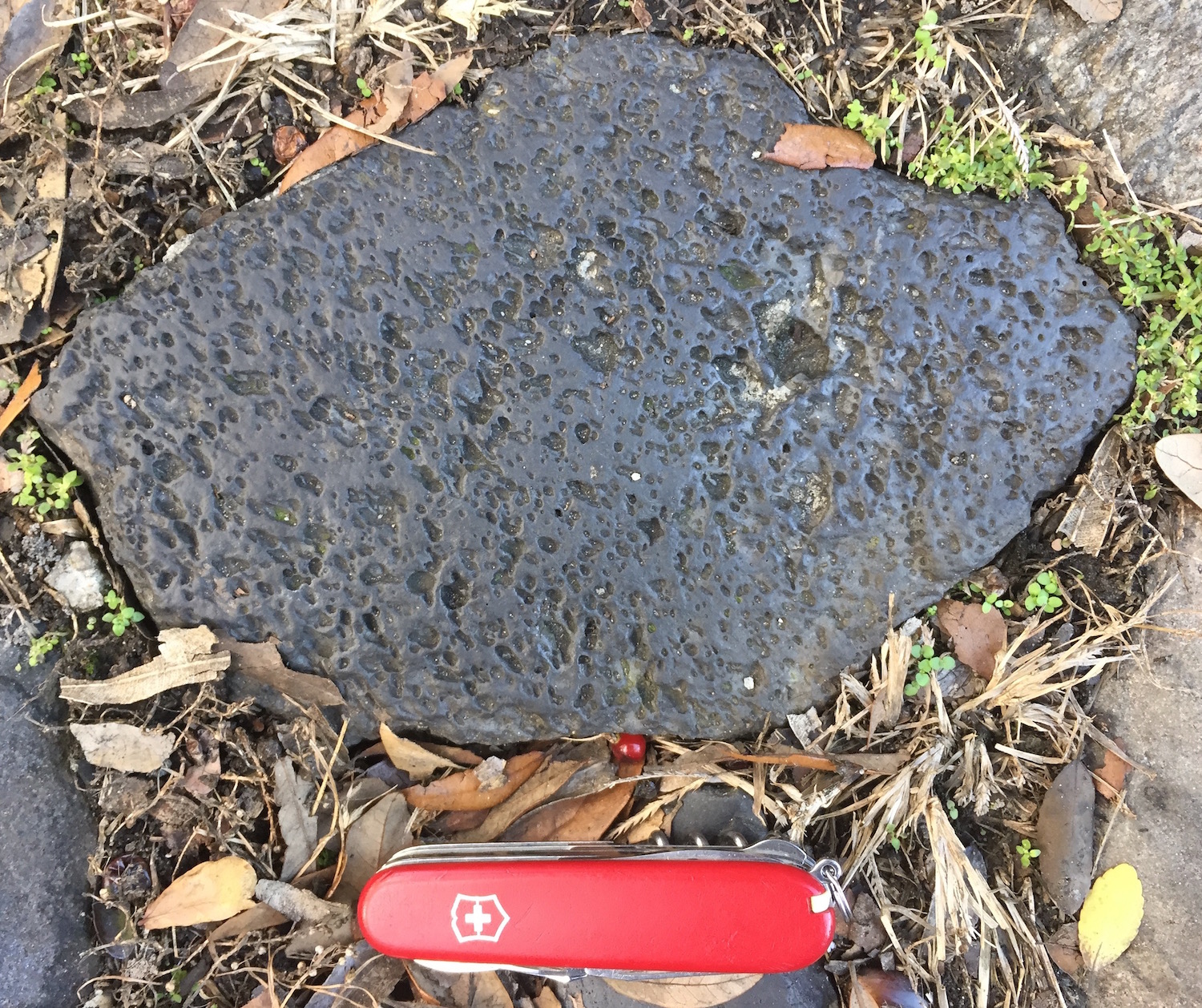 A good example of vesicular basalt, an igneous extrusive (volcanic) rock that formed from hot magma that cooled at or near the surface of the earth, and nowhere near present-day Savannah. The “vesicular” part of its name is from vesicles formed by gases in the magma, evidenced by those little holes in the rock. (Photo by Anthony Martin.)
A good example of vesicular basalt, an igneous extrusive (volcanic) rock that formed from hot magma that cooled at or near the surface of the earth, and nowhere near present-day Savannah. The “vesicular” part of its name is from vesicles formed by gases in the magma, evidenced by those little holes in the rock. (Photo by Anthony Martin.)
However, I also saw intrusive (plutonic) igneous rocks, at least one of which was intruded by basalt, defined by a clean, black band cutting across the older rock. Sedimentary rocks included sandstones, some of which were placed parallel to their original bedding, fitting like bricks in some of the walls above the street.
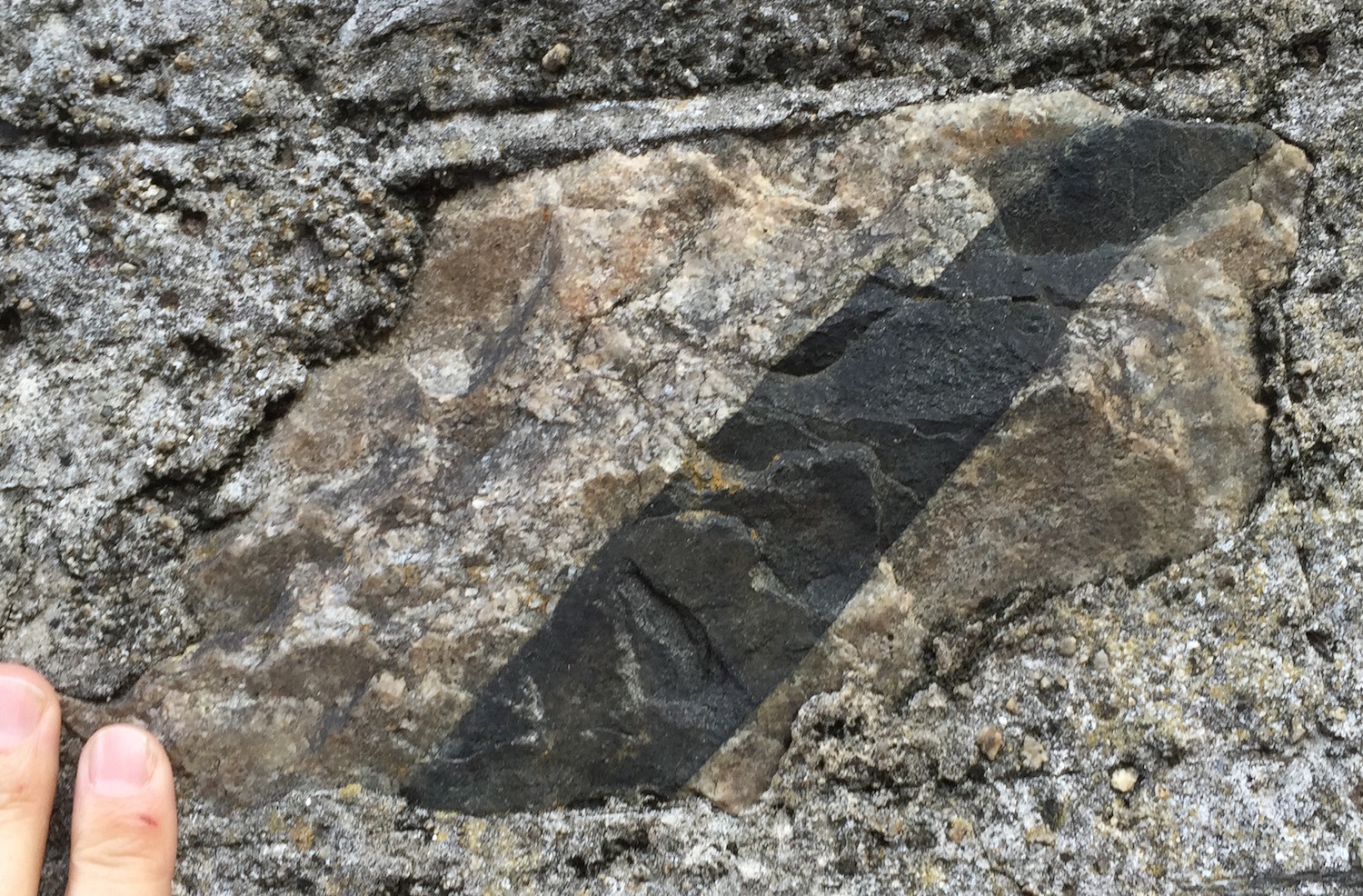 Forget paper and scissors: This time, rock cuts rock. The black band is a basalt dike, which is cutting across the coarser-grained igneous rock, which may be a pegmatitic granite. Based on the simple principle of cross-cutting relations, the basalt is geologically younger than the pegmatite. (Photo by Anthony Martin.)
Forget paper and scissors: This time, rock cuts rock. The black band is a basalt dike, which is cutting across the coarser-grained igneous rock, which may be a pegmatitic granite. Based on the simple principle of cross-cutting relations, the basalt is geologically younger than the pegmatite. (Photo by Anthony Martin.)
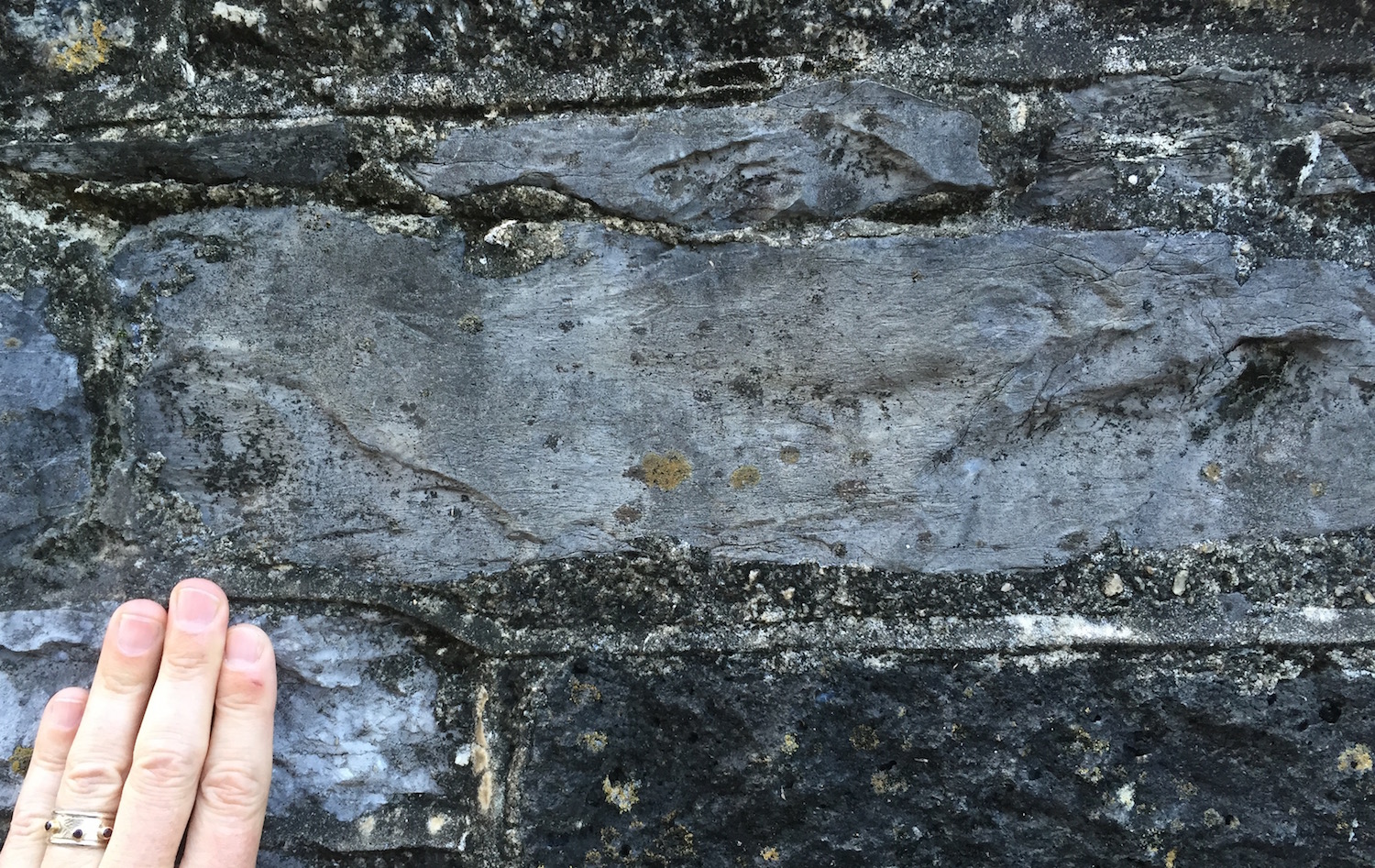 As a sedimentary geologist, I’m always happy to see a sedimentary rock, and this one was no exception. This sandstone had some low-angle cross-bedding, which was likely made by the sorting of sand, moved and deposited by water millions of years ago. (Photo by Anthony Martin.)
As a sedimentary geologist, I’m always happy to see a sedimentary rock, and this one was no exception. This sandstone had some low-angle cross-bedding, which was likely made by the sorting of sand, moved and deposited by water millions of years ago. (Photo by Anthony Martin.)
At least a few sedimentary rocks even contained fossils, such as a limestone with gorgeous length-wise and cross-sections of crinoid stems. This one was probably from the Carboniferous Period, from more than 300 million years ago. It was next to another limestone containing what looked to me like cyanobacterial or algal structures, called oncolites. Such rocks were common earlier in the Paleozoic Era, say, 450-500 million years ago.
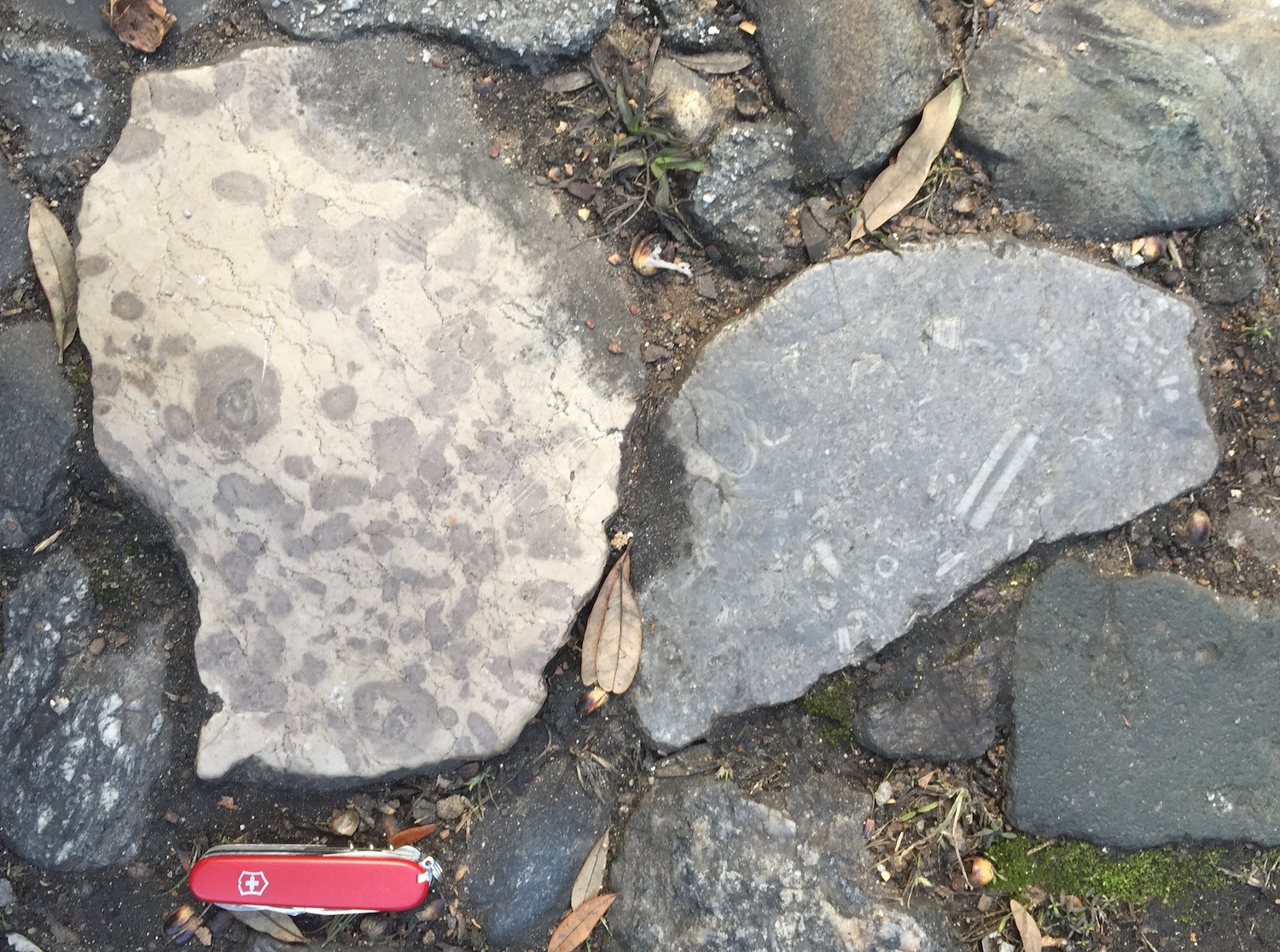 Limestones from another land, but now paving a street in Savannah, Georgia. The one on the left bears what I think are algal structures called oncolites, and the one on the right has nicely preserved crinoid parts. Where are they from, and what are their geological ages? I can only answer “Great Britain” for the former, and “Paleozoic” for the latter. But I suspect the oncolititic limestone is older (Cambrian) than the crinoidal limestone (Carboniferous). At any rate, these rocks are not from the Savannah area, which is composed of sands and muds from much more recent rivers and tides.
Limestones from another land, but now paving a street in Savannah, Georgia. The one on the left bears what I think are algal structures called oncolites, and the one on the right has nicely preserved crinoid parts. Where are they from, and what are their geological ages? I can only answer “Great Britain” for the former, and “Paleozoic” for the latter. But I suspect the oncolititic limestone is older (Cambrian) than the crinoidal limestone (Carboniferous). At any rate, these rocks are not from the Savannah area, which is composed of sands and muds from much more recent rivers and tides.
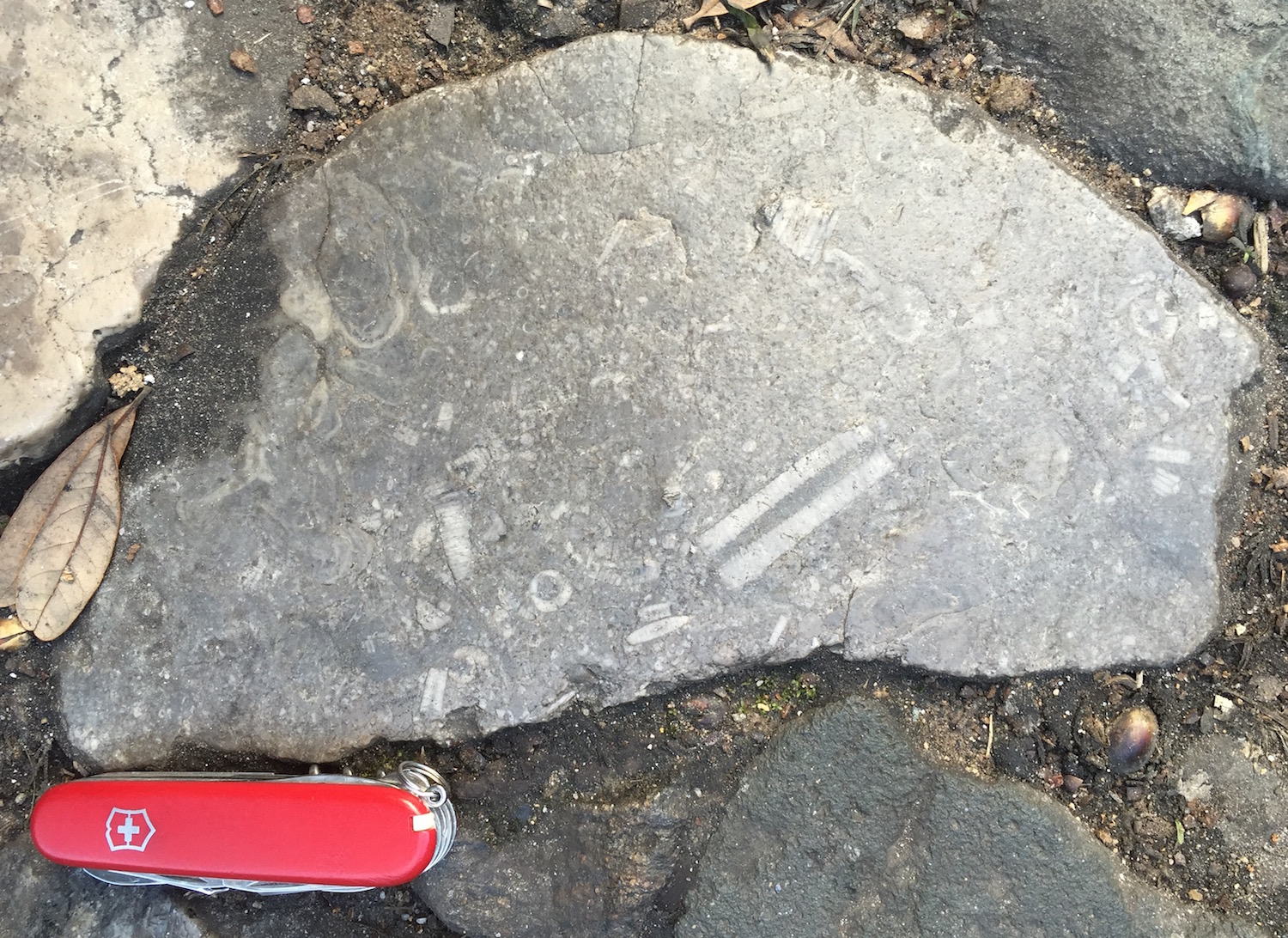 A close-up of that crinoidal limestone, with the length-wise section of a crinoid stem (center bottom) and cross-sections of their columnals throughout. (Photo by Anthony Martin.)
A close-up of that crinoidal limestone, with the length-wise section of a crinoid stem (center bottom) and cross-sections of their columnals throughout. (Photo by Anthony Martin.)
So like most normal people, you are probably wondering how these ballast stones relate to ichnology. For instance, do any of the sedimentary rocks contain trace fossils? Maybe, although I didn’t see any really convincing ones. Only one rock of the many I examined had some possible vertical burrows, exposed as holes in a sandstone cobble.
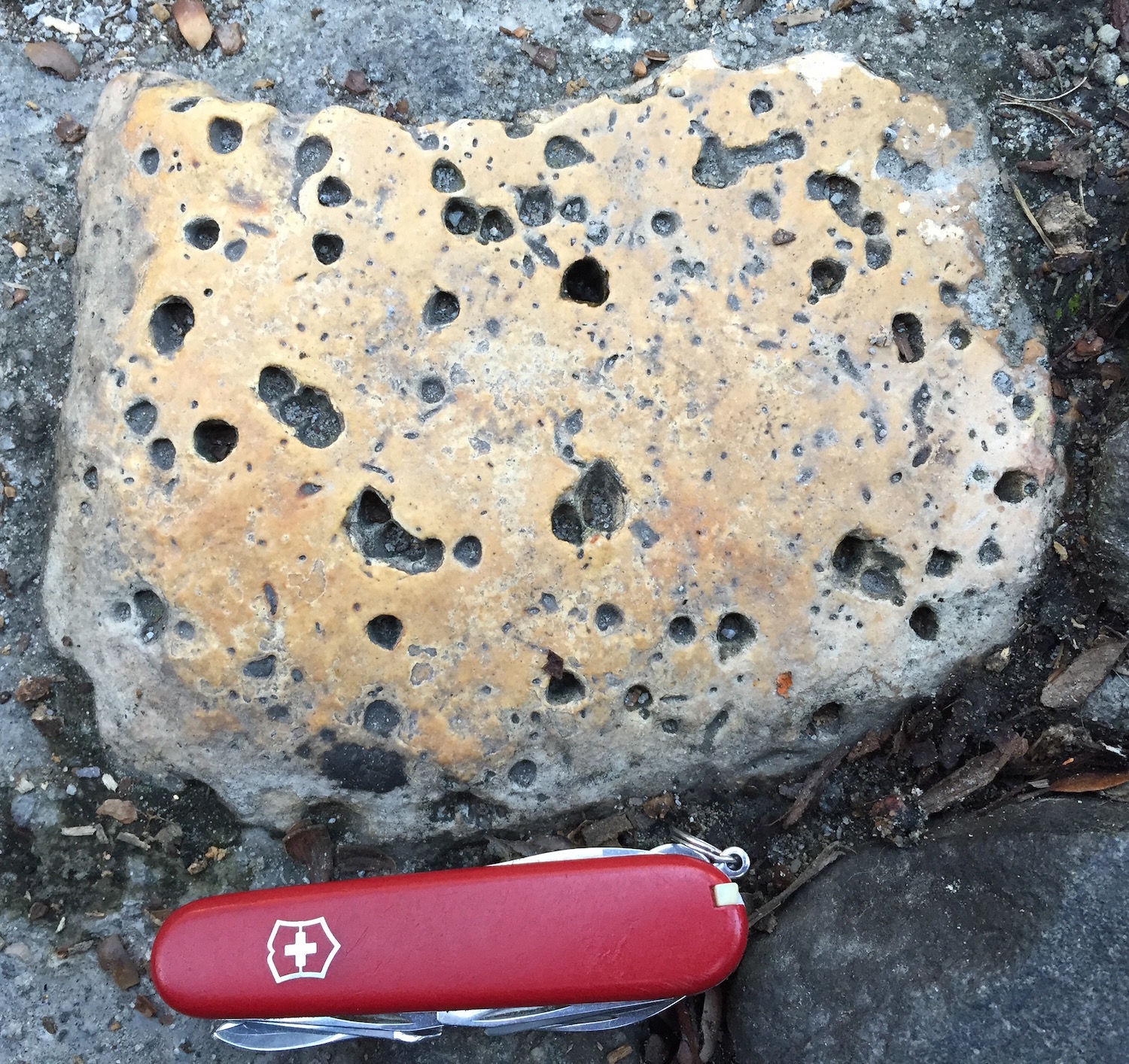 A sandstone with some good candidates for trace fossils, in which the holes may be cross-sections of vertical burrows. It may even have a U-shaped burrow, which looks like a little dumbbell when viewed from above (upper right). Sadly, out of all the rocks I saw on the street, I didn’t see any others like this, so I wasn’t able to test my hypothesis any further. (Photo by Anthony Martin.)
A sandstone with some good candidates for trace fossils, in which the holes may be cross-sections of vertical burrows. It may even have a U-shaped burrow, which looks like a little dumbbell when viewed from above (upper right). Sadly, out of all the rocks I saw on the street, I didn’t see any others like this, so I wasn’t able to test my hypothesis any further. (Photo by Anthony Martin.)
But there is another trace here, one much larger and more conceptual than what can be discovered in a single stone. Think of how these ballast stones collectively represent a human trace, tangible evidence of a grand transference of geological heritage from one continent to another.
From more of a moral perspective, however, these ballast stones are also a trace of slavery. The labor of enslaved people – abducted from their homes in western Africa and, like ballast stones, packed into cargo holds on ships and taken to a foreign land – produced the agricultural goods that went back in ships to Europe.
Although slavery was at first banned from Savannah, it was allowed soon after its founding (starting in 1750) and continued after American independence in the latter part of the 18th century. Savannah one of the most productive ports in the world for the shipping of rice and cotton during the antebellum times in the 19th century, and the heinous exploitation of human lives continuing until the advent of the American Civil War in the mid-1860s. This meant more ships arriving over the years, still bringing their ballast stones, and taking back cotton, rice, and other fruits of this cruel labor. Meanwhile, slave labor was also used to construct many of the streets, walls, and homes in Savannah composed of ballast stones.
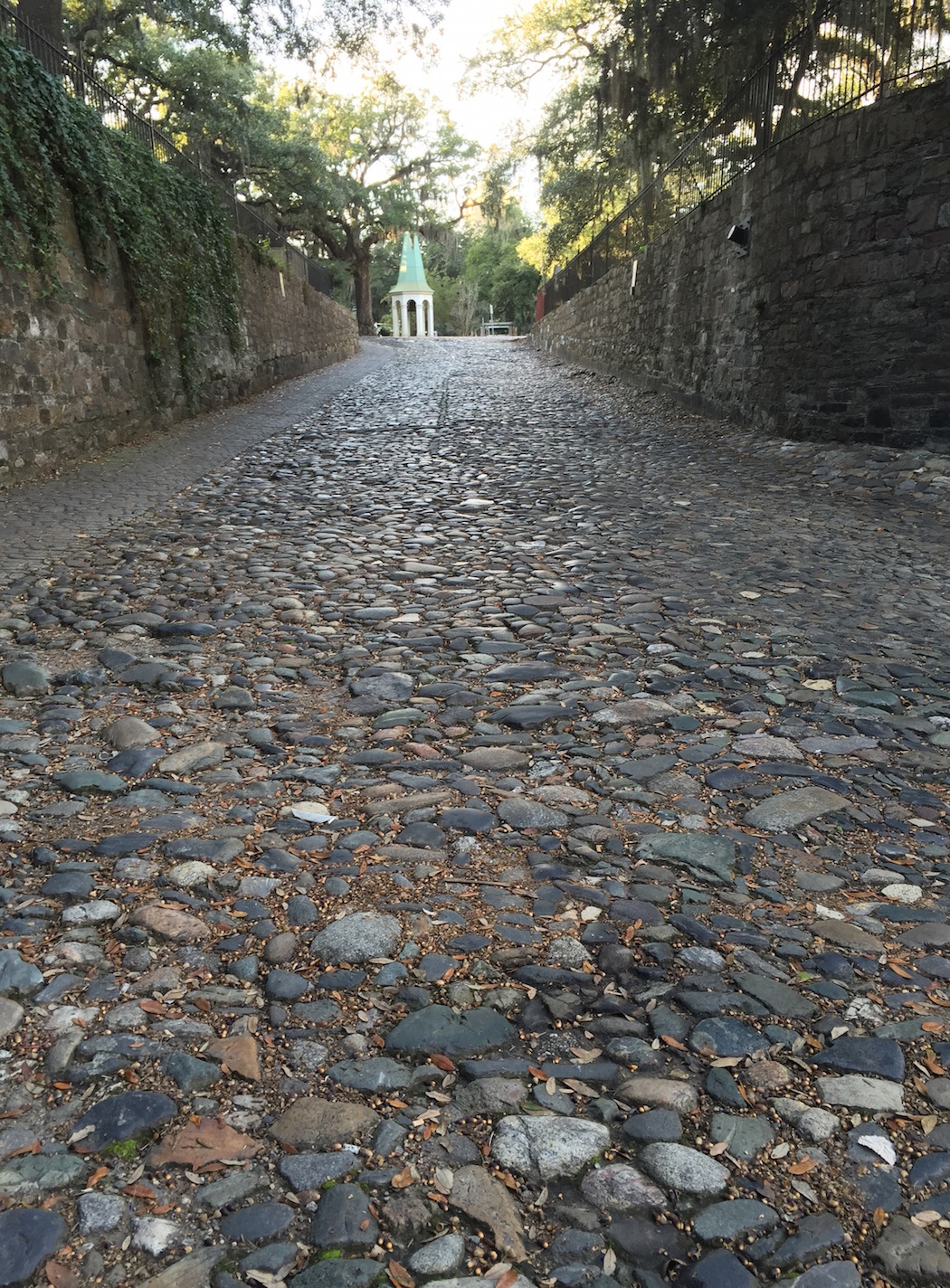 A Savannah street and walls, built with rocks from another land, and by people from another land, some of whom did not have a choice in building them.
A Savannah street and walls, built with rocks from another land, and by people from another land, some of whom did not have a choice in building them.
So there would be far fewer ballast stones on the streets and in the walls of Savannah if not for this brutal part of English and American history. The legacy of these stones also links to the family lineages of millions of African Americans, whether they live in Savannah, other parts of Georgia, the U.S., or abroad. As we walk on these rocks in the streets of Savannah, I am mindful of how their physical weight later became an emotional one, one still carried by many of us as we view and walk on these traces of that past.
 African American Family Monument, a bronze sculpture designed by Dorothy Spradley, on River Street in Savannah, Georgia. The foundation – which I think is composed of more geographically appropriate granite from Elberton, Georgia – is inscribed with the following words by Maya Angelou (1928-2014), which, like the ballast stones, remind us of a past we might like to forget, but should not.
African American Family Monument, a bronze sculpture designed by Dorothy Spradley, on River Street in Savannah, Georgia. The foundation – which I think is composed of more geographically appropriate granite from Elberton, Georgia – is inscribed with the following words by Maya Angelou (1928-2014), which, like the ballast stones, remind us of a past we might like to forget, but should not.
We were stolen, sold and bought together from the African continent. We got on the slave ships together. We lay back to belly in the holds of the slave ships in each others excrement and urine together, sometimes died together, and our lifeless bodies thrown overboard together. Today, we are standing up together, with faith and even some joy.
(For a bit more information about Savannah’s ballast stones, and to see them for yourself while visiting Savannah – which I highly recommend – visit the Historical Markers Database site at Savannah’s Cobblestones.)

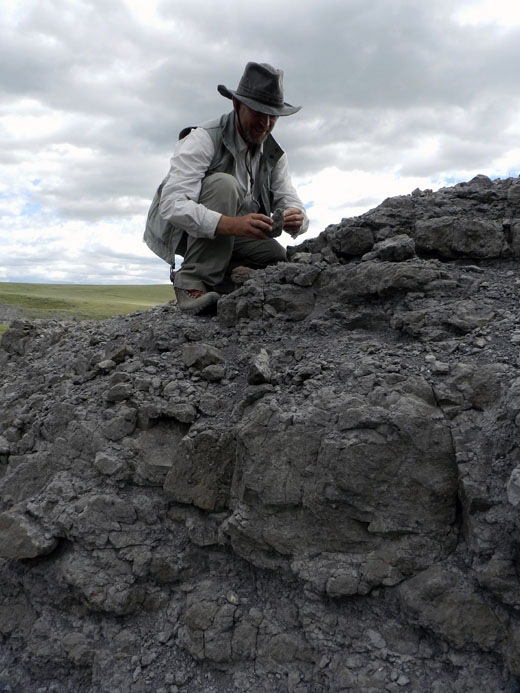
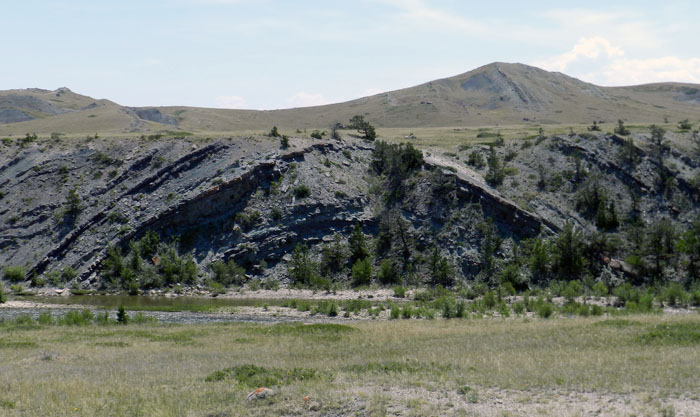

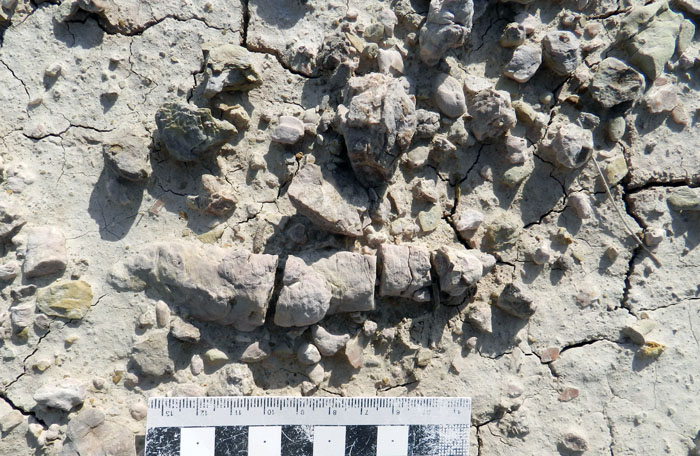
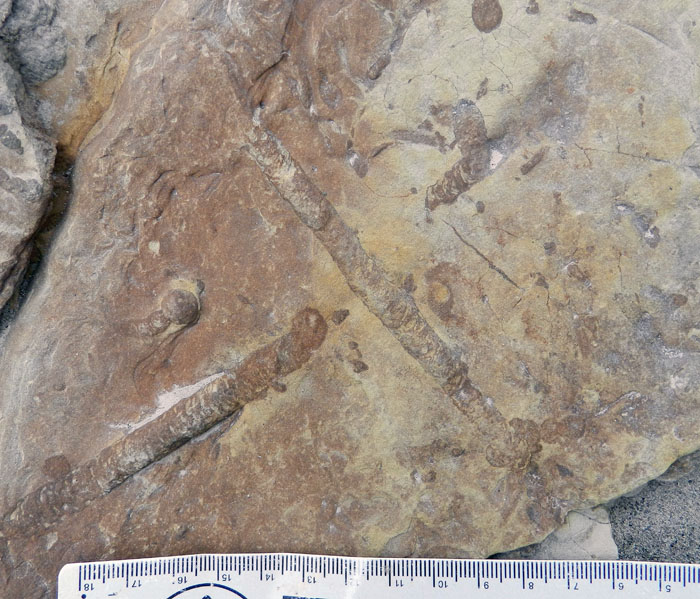
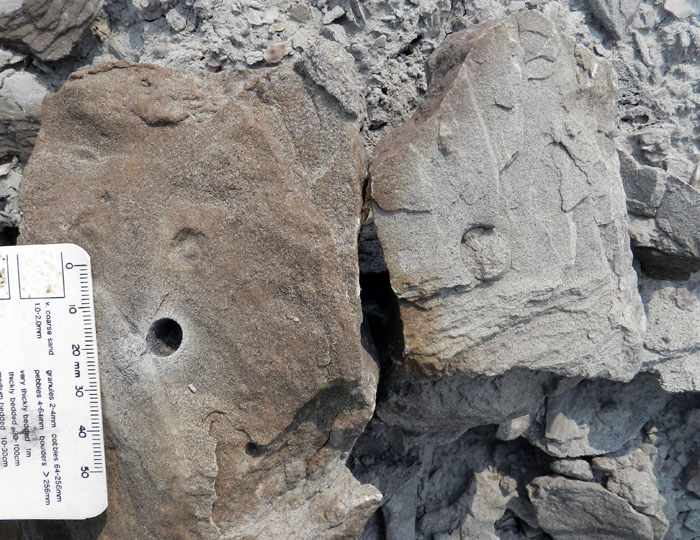
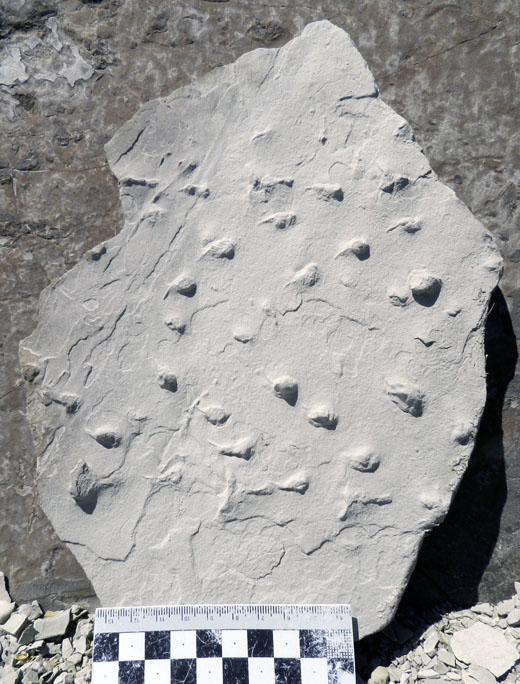
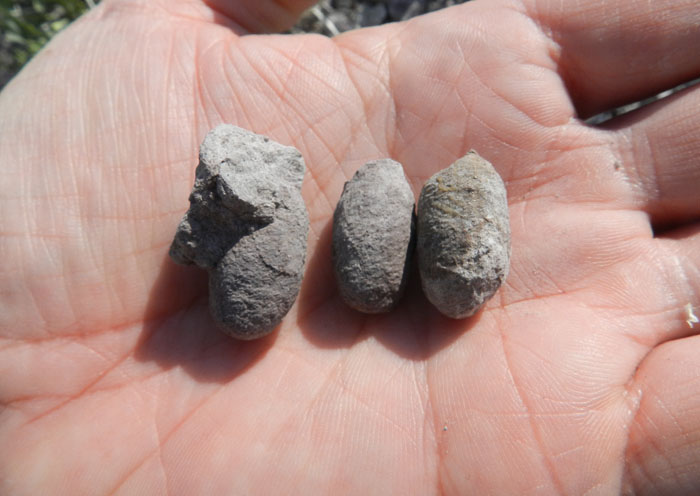
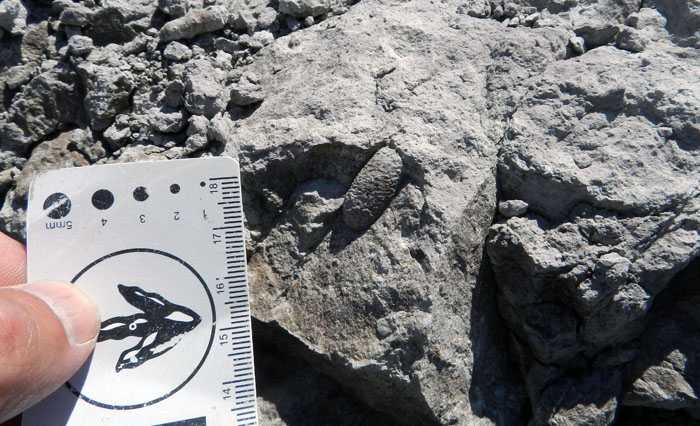
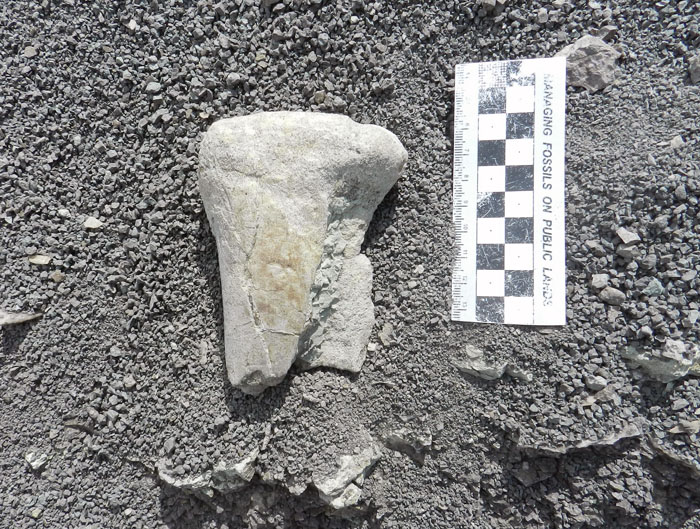

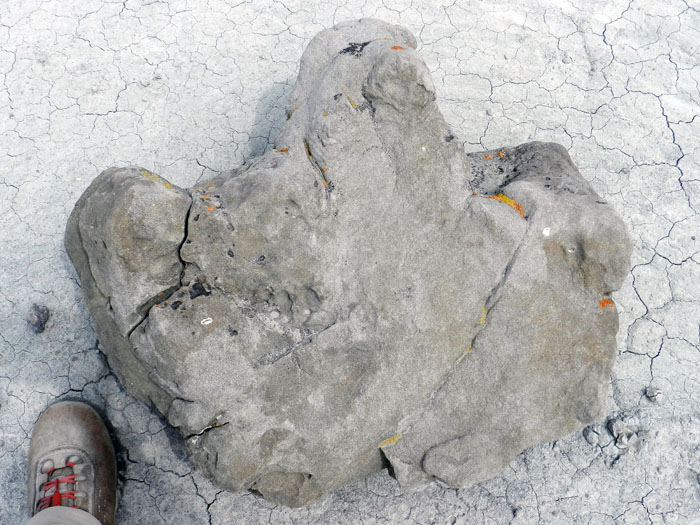
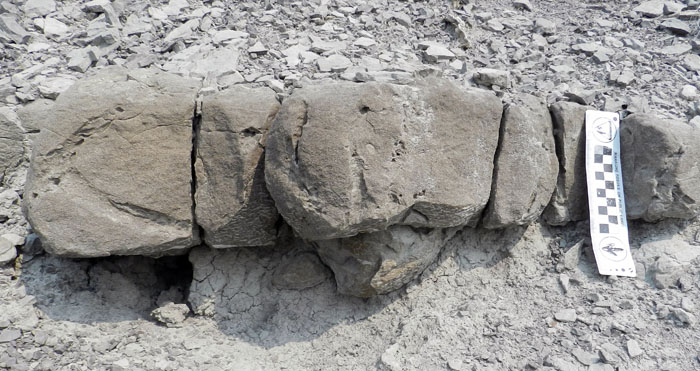
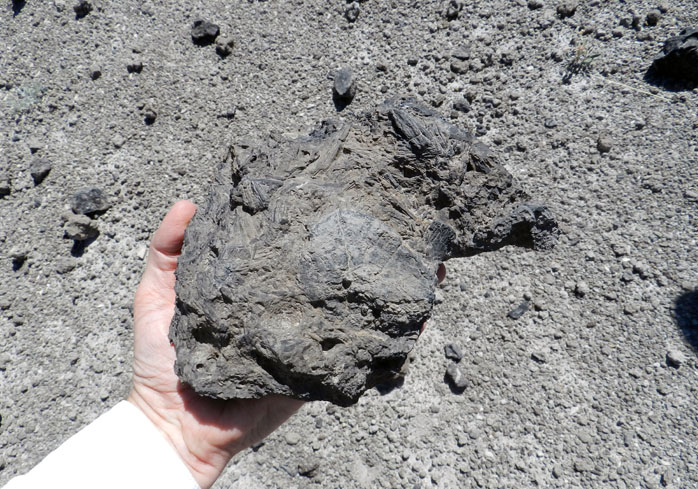
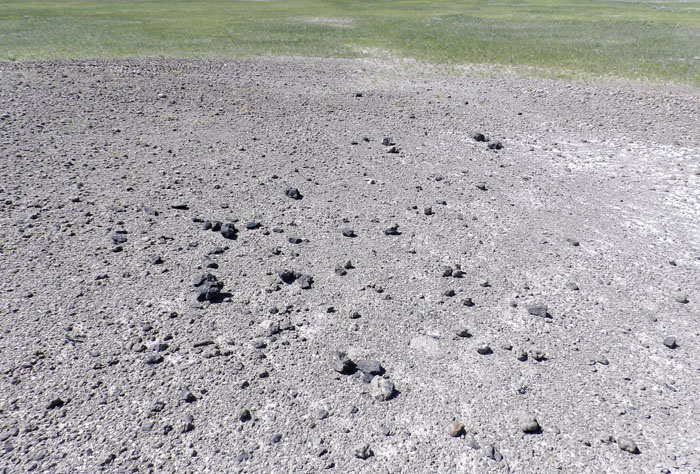 You’ve heard of ‘Field of Dreams’? This is a ‘Field of Feces.’ The ground here is adorned with dinosaur coprolites, which are weathering out of the mudstone and breaking apart on the surface. This serves as a good example of how once you know what the dinosaur coprolites look like in this area, you’re less likely to just walk by them, singing “Where Have All the Coprolites Gone?”. (Photograph by Anthony Martin.)
You’ve heard of ‘Field of Dreams’? This is a ‘Field of Feces.’ The ground here is adorned with dinosaur coprolites, which are weathering out of the mudstone and breaking apart on the surface. This serves as a good example of how once you know what the dinosaur coprolites look like in this area, you’re less likely to just walk by them, singing “Where Have All the Coprolites Gone?”. (Photograph by Anthony Martin.)